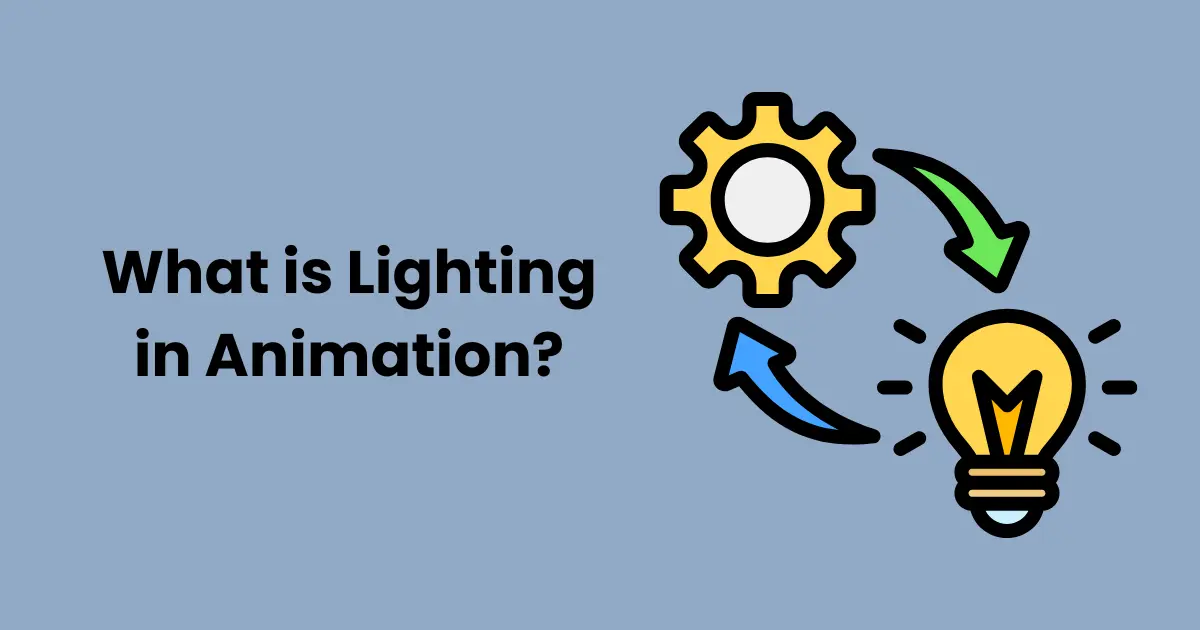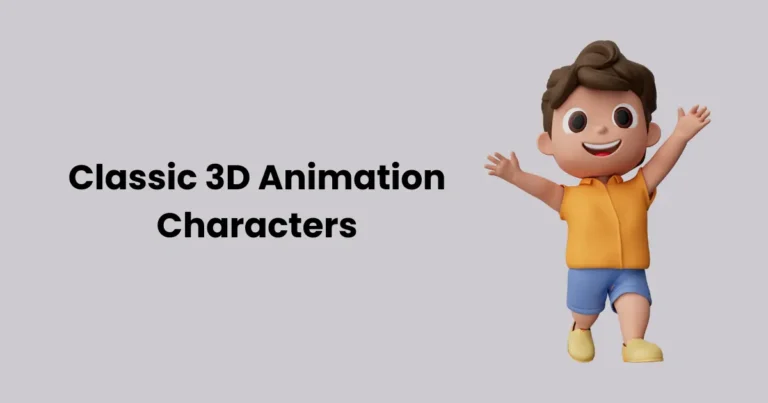What is Lighting in Animation | Tips and tricks for animators in 2024

Contents
- 1 Types of Lighting in Animation
- 2 Key Lighting Techniques in Animation
- 3 Tools and Software for Lighting in Animation
- 4 Impact of Lighting on Mood and Atmosphere
- 5 Lighting Challenges in Animation
- 5.1 1. Balancing Realism and Creativity
- 5.2 2. Rendering Time and Resource Management
- 5.3 3. Achieving Consistent Lighting
- 5.4 4. Handling Shadows and Reflections
- 5.5 5. Lighting for Different Materials and Textures
- 5.6 6. Capturing the Mood and Atmosphere
- 5.7 7. Dynamic Lighting for Moving Scenes
- 5.8 8. Managing Color Bleeding
- 5.9 9. Lighting for Different Mediums
- 6 Future of Lighting in Animation
- 6.1 1. Real-Time Rendering and Lighting
- 6.2 2. AI-Powered Lighting Tools
- 6.3 3. Virtual Reality (VR) and Augmented Reality (AR)
- 6.4 4. Physically Accurate Lighting
- 6.5 5. Volumetric and Atmospheric Effects
- 6.6 6. Sustainable Lighting Practices
- 6.7 7. Integration of Lighting and Storytelling
- 6.8 8. Expanding Accessibility
- 6.9 Conclusion
Lighting in animation is one of the most essential aspects of visual storytelling, transforming flat images into dynamic, emotionally resonant scenes. It involves the strategic use of light and shadow to enhance mood, focus attention, and create a sense of depth in animated visuals. Whether it’s the warm glow of a sunrise or the eerie shadows of a stormy night, lighting in animation is what breathes life into every frame.
In animation, lighting serves both an artistic and a functional purpose. It not only sets the tone for a scene but also directs the audience’s gaze, emphasizing key characters or actions. Mastering lighting in animation is crucial for animators who aim to create visually stunning and emotionally impactful work. From 2D hand-drawn styles to hyper-realistic 3D worlds, the role of lighting cannot be overstated.
By understanding the principles of lighting in animation, animators can craft immersive environments, convey powerful emotions, and elevate their storytelling to new heights. In this guide, we’ll delve into the techniques, tools, and importance of lighting, showcasing how this often-overlooked element is a cornerstone of animation artistry.
Types of Lighting in Animation
Lighting in animation can be categorized into several types, each serving unique purposes to enhance the visual and emotional impact of a scene. By understanding these types, animators can use lighting to craft realistic, stylized, or fantastical worlds. Here’s an in-depth look at the main types of lighting in animation:

1. Natural Lighting
This lighting in animation mimics the light found in the real world, such as sunlight, moonlight, or ambient light from the sky.
- Purpose: Creates a sense of realism and grounds animated scenes in reality.
- Examples: Soft morning light for a serene mood, harsh noon sunlight for dramatic effect, or dim moonlight for a mysterious tone.
This type of lighting in animation is commonly used to evoke relatable settings and enhance the audience’s immersion in the story.
2. Artificial Lighting
Artificial lighting is any light source created by human-made objects, such as lamps, neon signs, or headlights.
- Purpose: Adds drama, atmosphere, or stylization to a scene.
- Examples: A flickering streetlight in a noir setting, colorful nightclub lights, or the glow of a futuristic hologram.
This type of lighting in animation allows animators to explore imaginative and unique lighting setups that go beyond real-world limitations.
3. Creative Lighting Effects
This type of lighting focuses on imaginative or non-realistic sources of light to create a specific mood or enhance the storytelling.
- Purpose: Highlights fantasy, sci-fi, or abstract elements.
- Examples: Magical glowing orbs, otherworldly beams of light, or dynamic shadows that change based on character movements.
Creative lighting in animation is often used in fantasy and sci-fi genres to immerse audiences in extraordinary worlds.
Each type of lighting in animation offers animators an opportunity to shape the mood, guide the narrative, and create visually compelling scenes. By blending natural, artificial, and creative lighting, animators can achieve a perfect balance between realism and artistry.
Key Lighting Techniques in Animation
Lighting is more than just adding brightness to a scene; it is a powerful tool that animators use to shape emotions, define space, and tell stories. Here are some of the most important lighting techniques in animation that professionals rely on to create visually striking and emotionally resonant scenes:

1. Three-Point Lighting
Three-point lighting is a foundational technique that involves three light sources: key light, fill light, and backlight.
- Key Light: The main source of light that highlights the subject.
- Fill Light: A secondary light that softens shadows created by the key light.
- Backlight: Positioned behind the subject to separate it from the background and add depth.
This balanced setup is widely used in both 2D and 3D animation to create natural and professional-looking scenes.
2. Rim Lighting
It involves placing a light source behind or beside a subject to create a glowing edge or silhouette.
- Purpose: Adds depth and highlights the outline of characters or objects.
- Use Case: Frequently used in dramatic scenes to create contrast and enhance visual separation from the background.
Rim lighting is particularly effective in action and suspenseful sequences where emphasis on the subject is critical.
3. Ambient Lighting
Ambient lighting is a soft, diffused light that illuminates the entire scene without a clear direction.
- Purpose: Simulates natural light that bounces off surfaces to fill in gaps.
- Use Case: Used in scenes with a serene, calm, or uniform tone.
This technique ensures that no part of the scene appears unnaturally dark while maintaining a cohesive look.
4. Dynamic Lighting
This type of lighting involves moving or changing light sources within a scene.
- Purpose: Adds realism and enhances storytelling by mimicking real-world lighting changes, such as flickering fire or shifting sunlight.
- Use Case: Essential for interactive environments and dynamic scenes in 3D animation.
Dynamic lighting in animation creates a sense of movement and keeps viewers engaged.
5. Spot Lighting
Spotlighting focuses a beam of light on a specific area or character.
- Purpose: Directs the viewer’s attention to a focal point.
- Use Case: Often used in theatrical or dramatic moments to highlight key actions or emotions.
Spotlighting helps create tension, suspense, or a sense of importance in the scene.
By mastering these lighting techniques in animation, animators can dramatically enhance the storytelling and visual appeal of their projects. Each technique serves a specific purpose, allowing for creative and technical flexibility to suit any genre or style.
Tools and Software for Lighting in Animation
The evolution of animation software has empowered animators to achieve stunning lighting effects, enhancing realism and creativity in their projects. Here’s a comprehensive look at some of the best tools and software for lighting in animation, covering everything from beginner-friendly platforms to advanced professional-grade applications.

1. Autodesk Maya
Maya is a powerhouse in 3D animation, offering robust tools for creating and managing lighting setups.
- Key Features:
- High Dynamic Range Imaging (HDRI) for realistic lighting.
- Advanced ray tracing for accurate light simulations.
- Intuitive Light Editor for adjusting settings like intensity, shadows, and color.
- Use Case: Ideal for professional animators working on detailed 3D projects.
2. Blender
Blender is a free, open-source 3D creation suite with impressive lighting tools for all types of animation.
- Key Features:
- Cycles and Eevee render engines for realistic and real-time lighting.
- Node-based shader editor for customizable lighting effects.
- Global illumination for natural and diffused lighting.
- Use Case: Perfect for both beginners and professionals looking for a cost-effective solution.
3. Adobe After Effects
Adobe After Effects is widely used for 2D animations and compositing, with powerful lighting effects.
- Key Features:
- Built-in lighting effects like spotlights and ambient lights.
- 3D camera integration for dynamic lighting in animated scenes.
- Easy integration with other Adobe tools for post-production.
- Use Case: Best for adding lighting effects in 2D animation and compositing.
4. Unreal Engine
Unreal Engine, primarily known for game development, is a powerful tool for cinematic lighting in animation.
- Key Features:
- Real-time lighting tools for interactive environments.
- Volumetric fog and dynamic shadows for atmospheric effects.
- Support for HDR lighting and physically based rendering (PBR).
- Use Case: Suitable for animators creating high-quality 3D animations or virtual productions.
5. Pixar’s RenderMan
RenderMan, developed by Pixar, is a top-tier rendering software designed for photorealistic lighting.
- Key Features:
- Advanced ray tracing and global illumination.
- Tools for creating soft shadows and subsurface scattering.
- Optimized for feature film-level lighting.
- Use Case: Best for animators working on high-end cinematic projects.
6. Toon Boom Harmony
Toon Boom Harmony is a popular choice for 2D animators, offering specialized tools for lighting.
- Key Features:
- Built-in tools for shadows, highlights, and tone effects.
- Node-based workflow for flexible lighting adjustments.
- Real-time preview of lighting effects.
- Use Case: Ideal for animators focused on traditional or digital 2D animation.
7. Cinema 4D
Cinema 4D is known for its user-friendly interface and powerful lighting capabilities.
- Key Features:
- Advanced lighting tools such as area lights and volumetric lighting.
- Integration with third-party render engines like Redshift and Octane.
- Easy-to-use global illumination for natural lighting effects.
- Use Case: Great for motion graphics and stylized 3D animations.
8. Houdini
Houdini is a high-end software known for its procedural workflows and advanced lighting features.
- Key Features:
- Supports custom lighting rigs for unique setups.
- Physically based rendering (PBR) for realistic lighting.
- Seamless integration with simulation effects like smoke and fire.
- Use Case: Perfect for complex, dynamic animations and visual effects.
These tools and software offer diverse solutions for achieving stunning lighting in animation, whether you’re a novice or a seasoned professional. Selecting the right software depends on your animation style, budget, and project needs. By mastering these tools, animators can create visually compelling works that leave a lasting impact.
Impact of Lighting on Mood and Atmosphere
Lighting plays a pivotal role in shaping the emotional tone and atmosphere of any animated scene. It has the power to evoke feelings, guide the viewer’s perception, and immerse the audience in the story. Here’s how lighting in animation significantly impacts mood and atmosphere:

1. Enhancing Emotional Tone
Different lighting setups can evoke a wide range of emotions, from joy to fear.
- Warm Lighting: Soft, warm tones like yellows and oranges create a sense of comfort, happiness, or nostalgia. For example, a sunset scene with golden light evokes peace and sentimentality.
- Cool Lighting: Blues and greens often convey sadness, mystery, or calmness. A dimly lit, blue-hued scene can evoke loneliness or introspection.
By manipulating light intensity and color, animators can amplify the emotional resonance of a scene.
2. Creating Tension and Suspense
Lighting is instrumental in building tension and suspense in animation.
- Low-Key Lighting: A technique that uses stark contrasts and deep shadows to create a dramatic or eerie effect. Often used in horror or thriller genres, it heightens fear and uncertainty.
- Dynamic Lighting: Flickering lights or moving shadows can add unpredictability, keeping the audience on edge.
This use of lighting in animation is crucial for storytelling that demands a heightened emotional response.
3. Setting the Scene’s Atmosphere
Lighting defines the atmosphere of an environment, helping viewers understand the context of a scene.
- Bright and Cheerful: High-intensity light with minimal shadows creates a vibrant, lively atmosphere, often seen in comedies or children’s animations.
- Dark and Somber: Dim, muted lighting with heavy shadows evokes mystery, melancholy, or danger. Ideal for dramatic or dystopian narratives.
Lighting can seamlessly transition the audience between different atmospheres, enhancing their connection to the story.
4. Guiding Viewer Attention
Lighting is a powerful tool to direct the audience’s focus within a scene.
- Spotlighting: Using light to illuminate a specific character or object emphasizes its importance.
- Silhouetting: Backlighting can make characters stand out against the background, creating intrigue or mystery.
These techniques ensure that the viewer remains engaged with the narrative by highlighting key elements.
5. Adding Depth and Realism
In animation, lighting is essential for creating the illusion of depth and realism.
- Soft Shadows and Highlights: Mimic the way light interacts with objects in the real world, making scenes feel tangible.
- Volumetric Lighting: Adds atmospheric effects like fog or light beams, enhancing the realism and mood of a scene.
This dimension of lighting in animation contributes to immersive storytelling and a believable world.
The impact of lighting in animation on mood and atmosphere cannot be overstated. It is a vital storytelling tool that goes beyond aesthetics, influencing how scenes are perceived and felt by the audience. By mastering lighting techniques, animators can craft visually stunning works that leave a lasting emotional impact.
Lighting Challenges in Animation
Creating effective and visually compelling lighting in animation comes with its own set of challenges. These obstacles can range from technical limitations to artistic constraints, each requiring innovative solutions and careful planning. Below are some common challenges animators face while implementing lighting in their projects:

1. Balancing Realism and Creativity
- Challenge: Striking a balance between realistic lighting and the artistic style of the animation can be tricky. While realism helps immerse viewers, excessive realism might clash with stylized or fantastical settings.
- Solution: Use physically-based lighting techniques but adapt them to fit the artistic direction of the project. For example, exaggerate colors and shadows to suit a cartoon or fantasy world.
2. Rendering Time and Resource Management
- Challenge: Complex lighting setups, especially in 3D animation, significantly increase rendering time and demand higher computing power. Realistic effects like ray tracing, global illumination, and volumetric lighting can be computationally expensive.
- Solution: Optimize lighting rigs by minimizing unnecessary light sources and using pre-rendered environments where possible. Leveraging real-time rendering engines like Unreal Engine can also reduce processing demands.
3. Achieving Consistent Lighting
- Challenge: Maintaining consistent lighting across different shots and scenes is crucial to avoid disrupting the flow of the animation. Disparities in light intensity or color can make scenes feel disjointed.
- Solution: Create a lighting template or reference guide to ensure uniformity. Use tools like light linking and color grading in post-production to correct inconsistencies.
4. Handling Shadows and Reflections
- Challenge: Generating realistic shadows and reflections can be complex, especially when dealing with intricate objects or dynamic scenes. Poorly rendered shadows or reflections can break immersion.
- Solution: Use advanced techniques like ray tracing or shadow mapping to ensure accurate results. Adjust shadow quality and resolution based on the distance from the camera to optimize performance.
5. Lighting for Different Materials and Textures
- Challenge: Different materials (e.g., glass, metal, fabric) react uniquely to light. Poor lighting can result in unrealistic appearances, diminishing the quality of the animation.
- Solution: Use physically-based rendering (PBR) and material-specific lighting adjustments to accurately simulate how light interacts with various surfaces.
6. Capturing the Mood and Atmosphere
- Challenge: Designing lighting that aligns with the emotional tone and atmosphere of a scene can be subjective and difficult to perfect.
- Solution: Experiment with different color schemes, intensities, and angles. Conduct visual tests to determine which lighting setups best convey the intended mood.
7. Dynamic Lighting for Moving Scenes
- Challenge: Animating light sources for scenes with moving characters or objects requires precise timing and adjustments to avoid unnatural effects.
- Solution: Use dynamic lighting techniques such as real-time updates and automated keyframing to ensure smooth transitions. Test scenes rigorously to spot and correct lighting mismatches.
8. Managing Color Bleeding
- Challenge: In realistic lighting scenarios, colors from objects can unintentionally bleed into other areas, causing unwanted visual effects.
- Solution: Adjust global illumination settings and use light blockers to control color bleeding. Fine-tune materials to prevent exaggerated reflections or color transfers.
9. Lighting for Different Mediums
- Challenge: Lighting techniques in 2D and 3D animation differ significantly. Adapting lighting styles to suit the medium while maintaining artistic coherence is challenging.
- Solution: For 2D animation, use gradient shading and tone effects. For 3D animation, employ advanced tools like HDRI and volumetric lighting to create depth.
Overcoming the challenges of lighting in animation requires a combination of technical expertise, artistic insight, and strategic planning. By addressing these challenges, animators can ensure their lighting choices elevate the storytelling, enhance the visual quality, and captivate the audience.
Future of Lighting in Animation
The field of lighting in animation is continuously evolving, driven by advancements in technology and the growing demands for high-quality visuals. The future holds exciting possibilities, as new tools and techniques redefine how animators approach lighting. Below are key trends and innovations shaping the future of lighting in animation:

1. Real-Time Rendering and Lighting
- Advancement: Real-time rendering engines like Unreal Engine and Unity are revolutionizing animation lighting, enabling instant feedback and adjustments.
- Impact: Animators can test various lighting setups in real time, reducing production time and allowing for greater experimentation. This technology is particularly beneficial for interactive media like video games and virtual reality.
2. AI-Powered Lighting Tools
- Advancement: Artificial Intelligence is being integrated into animation workflows to automate complex lighting tasks. AI can analyze scenes and suggest optimal lighting setups, reducing the need for manual adjustments.
- Impact: AI-powered tools will streamline production pipelines, especially for smaller studios, enabling them to achieve professional-grade lighting with fewer resources.
3. Virtual Reality (VR) and Augmented Reality (AR)
- Advancement: The rise of VR and AR applications demands immersive lighting solutions. Dynamic and interactive lighting will become essential for creating believable environments in these mediums.
- Impact: Lighting will need to adapt in real time to user interactions, enhancing realism and engagement in VR and AR experiences.
4. Physically Accurate Lighting
- Advancement: As rendering engines improve, the ability to simulate physically accurate lighting will become more accessible. Techniques like global illumination and ray tracing will continue to dominate.
- Impact: Animations will achieve unprecedented realism, with lighting behaving as it does in the real world, enhancing immersion and audience impact.
5. Volumetric and Atmospheric Effects
- Advancement: The use of volumetric lighting and atmospheric effects, such as fog and light scattering, is becoming more sophisticated.
- Impact: These effects will allow animators to create highly atmospheric and emotionally resonant scenes, adding depth and texture to animated worlds.
6. Sustainable Lighting Practices
- Advancement: With a focus on reducing environmental impact, studios are exploring energy-efficient rendering solutions and optimizing lighting workflows to conserve computational resources.
- Impact: Sustainable practices will lower production costs and energy consumption, making animation more eco-friendly without compromising quality.
7. Integration of Lighting and Storytelling
- Advancement: Lighting is increasingly being recognized as a core storytelling tool. Future developments will focus on integrating lighting with narrative elements, using AI and data-driven insights to craft emotionally compelling scenes.
- Impact: Lighting will not just illuminate a scene but actively contribute to the story, enhancing the audience’s emotional connection to the characters and plot.
8. Expanding Accessibility
- Advancement: Tools like Blender, which are open-source and user-friendly, are leveling the playing field for independent animators and small studios.
- Impact: As lighting tools become more accessible, a broader range of creators can experiment with advanced lighting techniques, fostering innovation and creativity across the industry.
The future of lighting in animation is poised to be both technologically advanced and artistically transformative. Innovations in real-time rendering, AI, and immersive media will empower animators to create more dynamic, realistic, and engaging visuals. As lighting continues to evolve, it will remain a cornerstone of storytelling, shaping how audiences experience animated worlds.
Conclusion
Lighting in animation is far more than a technical aspect—it is a powerful storytelling tool that shapes the mood, atmosphere, and overall visual impact of a scene. From the realistic depth of shadows to the dramatic interplay of light and color, effective lighting breathes life into animated worlds. As the animation industry evolves, the role of lighting becomes increasingly pivotal, blending artistry with cutting-edge technology to deliver immersive experiences. By mastering lighting techniques, animators can elevate their work, ensuring that every scene not only captivates the audience but also communicates the intended narrative and emotion.
Looking to the future, innovations in lighting are set to redefine the possibilities of animation. The integration of real-time rendering, AI-driven tools, and immersive mediums like VR and AR is transforming how light interacts with animated spaces. These advancements will make lighting more accessible, efficient, and impactful, enabling animators to push creative boundaries. Whether creating fantastical worlds or deeply realistic settings, lighting will continue to play an essential role in shaping the way audiences connect with stories on screen.






